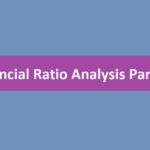Brief Description of Financial Statement
You can look at the financial statement from two perspectives.
- from the perspective of the creator
- from the point of view of the user
A person making financial statements usually comes from an accounting background. Ledger Entry i.e. account entry, matching of bills and receipts, matching the inflow and outflow of money, all these are his day-to-day work. Its objective is to create a transparent financial statement that can accurately reflect the financial condition of the company. The skills required to prepare such financial statements are acquired during the training of a chartered accountant.
On the other hand, the person using the financial statement only wants to understand that statement. He just has to use it. He does not need to know and understand every little detail about the journal entry or audit. He only means so that he can read the financial statement and make his decision about the stock of the company.
People generally have a misconception that a fundamental analyst should have a good understanding of the methodology of preparing financial statements. It is good to have this understanding, but it is important – it is not so. To become a fundamental analyst, you only need to know how to use financial statements, it is not necessary to know how to create them.
The company gives three specific information in the financial statement:
- Profit and loss statement (Profit and loss statement)
- Balance Sheet
- Cash flow statement
In the next few lessons, we’ll learn how to use all three.
Profit and Loss Statement (P&L statement)
Profit and Loss Statement or P&L statement is also called Income Statement, Statement of Operations or Statement of Earnings. The profit and loss statement shows the transactions that took place during a particular period. It contains information about the following things-
- Earnings of the company over the specified time period (annual or quarterly)
- income earned
- Tax & Depreciation
- Earning per share number i.e. Earning per share number
My experience says that the best way to understand a financial statement is to look at the actual statement and understand the information contained therein. Here is shown the P&L statement of Amara Raja Batteries Limited (ARBL). Its understand every line item.

Topline of the company (Revenue)
You must have heard many times the experts talking about the top line of the company. In fact, they are talking about the revenue of the P&L statement. The company first mentions the revenue or income number in its P&L.
Before we start understanding this, let us know some things written in the header of the P&L statement.

The header clearly states that..
P&L Statements are for the year ended 31st March 2014. This means this is an annual statement, not a quarter. Also, if it is a statement as of March 31, 2014, then it is a statement for FY 2013-14 or FY14.
All numbers given here are in million rupees. Note – 1 million is equal to 10 lakh rupees. It completely depends on the company in which unit it would like to give the number given in the statement.
Here’s a description of all the main things and any associated notes (also called schedules), given in the section of the note. Each note has a unique note number.
Traditionally, companies give the current year’s number in the left column and the previous year’s number in the right column in their financial statements. In this example the number for FY14 and the number for FY13.
The first line item on the revenue side is the sale of products, that is, the sale of goods.
Since here we are discussing a battery manufacturer, so here the sale of product means the total number of batteries sold by the company in FY14. The total sales figure is- Rs 3804,12,70,000, i.e. Rs 3804 crore. The company had sold batteries worth Rs 3294 crore in the last year i.e. FY13.
I am deliberately giving figures in crores here because I think it will be easier to understand.
The next line item is excise duty. The company will pay this Rs 400 crore to the government. This will be deducted from the income of the company.
The figure obtained after deducting excise duty is called Net Sales of the company. ARBL’s net sales in FY14 is Rs 3403 crore as against 2943 crore in FY13.
In addition to the sale of products, the company also generates revenue from the sale of services. Here it can mean the annual maintenance of the battery. The company earned Rs 30.9 crore in FY14 from the sale of services.
The company has also earned Rs 2.1 crore from other operating revenue i.e. other working income. This income is derived from the sale of certain goods and services that are connected with the core business of the company.
Finally, Total Operating Revenue is shown as Sales of Product + Sales of Service + Other Operating Revenue. This is Rs.3436 crores in FY14 as compared to Rs.2959 crores in FY13. A note has also been given here which is number 17. It is linked to the Net Revenue from Operations i.e. the net income generated from the operation. We shall see this properly later.
You may recall that in the previous chapter, we talked about the notes and schedules appearing in the financial statements.
The picture below is showing the details of this Note 17.

It is clear that in this note detailed information about the revenues from operations has been given, which gives us an idea of its different parts. As you can see, in section A, the sale of the product i.e. the sale of goods is divided into some parts.
In FY14, Rs 3523 crore was earned from the sale of finished goods as compared to Rs 3036 crore in FY13.
The finished goods of the last financial year, which is called stock in trade in English, were sold at Rs 208 crore in the current year FY14, as compared to Rs 149 crore in FY13.
The company earned Rs 71 crore in FY14 by selling UPS. In FY13, this earning was 109 crores.
The company earned Rs 3403 crore after paying excise duty from the sale of its products, which matches the figures given in the company’s P&L.
Similarly, you can also see the parts of the earnings from services i.e. services. It earned Rs 30.9 crore, which is in line with the P&L figures.
In the note, the company has said “Sale of Process Scrap” has earned Rs 2.1 crore. Note here that the sale of process scrap is the core business of the company, so it is classified under Other Operating Revenue.
Adding all types of revenue i.e. income, the net revenue i.e. net income is revealed, like 3403 crores + 30.9 crores + 2.1 crores = Rs 3436 crores
You will see the same in the statement for FY13.
If you pay attention, you will see that ARBL has shown other income i.e. other income of Rs 45.5 crore apart from net revenue on P&L statement. Note number 18 shown below explains what items come under other income.
As we can see that other income includes income or income which is not connected with the core business of the company. Interest on bank deposits, dividends, insurance claims, income from royalty, etc. come under other income. Usually other income is a small part of the total income, and it should be so. If the contribution of other income is high, it could be a sign of something wrong and needs to be investigated.
So by adding the income from the main business of the company, also called revenue from operations, (Rs 3436 crore) and other income (Rs 45 crore), the total income of the company in FY14 will be Rs 3482 crore.
Highlights of this chapter:
- The financial statement gives information about the company and also tells about the financial condition of the company.
- A financial statement consists of profit and loss account, balance sheet and cash flow statement.
- A fundamental analyst uses financial statements and must be very aware of what the statement makers are saying through the statement.
- The profit and loss statement tells how much profit or loss was made by the company in any given year.
- The profit and loss statement is an estimate, as the company’s figures are subject to change at a later date.
- Also, the company gives the figures for the current year and the previous year side by side in the statement.
- The revenue side of the P&L is also called the top line.
- Revenue from operations is the income from the main business of the company.
- Any other income related to the main business is kept under Other Operating Income.
- Earning from any other source comes under Revenue from non-operative sources.
- Revenue from Operations (- Duty) + Other Operating Income + Other Income = Net Revenue from Operations (Net Earning)

Gaurav Heera is a leading stock market educator, offering the best stock market courses in Delhi. With expertise in trading, options, and technical analysis, he provides practical, hands-on training to help students master the markets. His real-world strategies and sessions make him the top choice for aspiring traders and investors.





